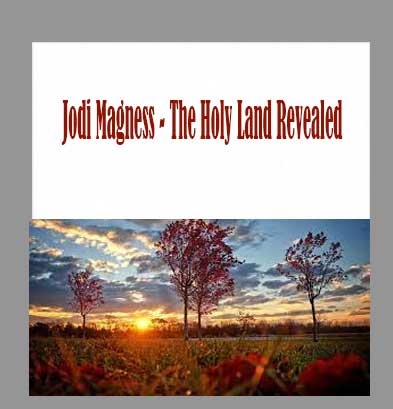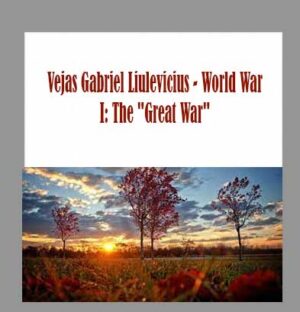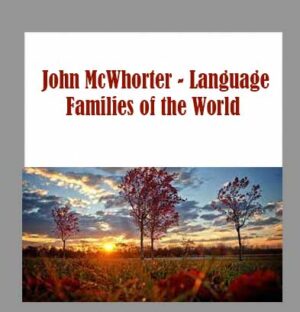Description
Jodi Magness – The Holy Land Revealed download, Jodi Magness – The Holy Land Revealed review, Jodi Magness – The Holy Land Revealed free
Jodi Magness – The Holy Land Revealed
The Holy Land Revealed
Visit the birthplace of Judaism and Christianity in this comprehensive tour, taught by an archaeologist, that will take you deep beneath the pages of the Bible.
LECTURE (36)
01:The Land of Canaan
What do we mean by “holy land� What is the difference between archaeology and history? How reliable is the Hebrew Bible as a window into life in ancient Israel? Discover answers to these and other questions in this introductory lecture, and take a peek at the region’s earliest recorded inhabitants, the Canaanites.
02:The Arrival of the Israelites
Explore what archaeologists have uncovered about the arrival of the Israelites into Canaan. Among the many intriguing artifacts you examine are an ancient Egyptian stele featuring the earliest reference to Israel, the remains of Jericho’s walls, and a Philistine temple similar to the one Samson destroyed in the book of Judges.
03:Jerusalem-An Introduction to the City
Here, survey the topography and layout of Jerusalem-perhaps the most important city in religious history. Then, review biblical accounts of Jerusalem from the arrival of David around 1000 B.C.E. to the start of the Babylonian exile in 586 B.C.E. (including the remains of a dramatic Assyrian siege on the city of Lachish).
04:The Jerusalem of David and Solomon
In this first lecture on the remains of the biblical City of David, comb through the fascinating remains of a scribe’s house located behind a city wall; grasp the development of biblical Hebrew script; and examine rare examples of this script in a clay sealing, a piece of pottery, and a victory stele.
05:Biblical Jerusalem’s Ancient Water Systems
Continue your archaeological exploration of the City of David by focusing on its ancient water system, centered on the Gihon Spring. Learn about the three different water systems that were created-Warren’s Shaft, Siloam Channel, and the impressive engineering feat of Hezekiah’s Tunnel-due to the spring’s location outside the city walls.
06:Samaria and the Northern Kingdom of Israel
Turn now to Israel as it was ruled under the Omride dynasty between Solomon’s death and the Assyrian invasion in 722 B.C.E. Here, explore important ruins, including the High Place at Dan (where the cult statue of a golden calf once resided) and the acropolis at Samaria (which holds the remains of King Ahab’s palace).
07:Fortifications and Cult Practices
Delve into aspects of everyday life in the kingdoms of ancient Israel. Focus on how elaborately recessed gates were designed to protect cities like Gezer from enemies, and how altars, amulets, painted figures, and inscribed pottery vessels reflect the religious beliefs and practices at Kuntillet Ajrud and other sites.
08:Babylonian Exile and the Persian Restoration
In 539 B.C.E., after the Babylonians were subsumed by the Persian Empire, the exiled Judeans were allowed to return to Jerusalem. So what happened next? Find out with this penetrating look at the Persian administration of the Holy Land, the influence of Ezra and Nehemiah, and the birth of early Judaism.
09:Alexander the Great and His Successors
Alexander the Great’s conquests of the Near East introduced Greek culture to the Holy Land. Professor Magness uses archaeological findings- including the personal belongings of murdered Samaritans and the remains of towers at an ancient fortification-to illustrate the profound influences of Alexander and his successors.
10:The Hellenization of Palestine
Continue examining the Hellenistic influence on the Holy Land-this time on non-Jewish populations in the area. Focus on three distinct cities: Iraq el-Amir (with the remains of an impressive temple or pleasure palace); Marisa (with its fascinating series of caves); and Tel Dor (with its distinctly Hellenistic architectural style).
11:The Maccabean Revolt
Turn now to the impact of the Greeks on the Jewish population of Judea. Tour the tumultuous years between 167 and 103 B.C.E., which saw Antiochus IV’s imposition of Greek beliefs on the population; the subsequent revolt under Judah Maccabee; the reigns of the Hasmoneans; and more.
12:The Hasmonean Kingdom
In this investigation of the Hasmoneans, meet individuals including the cruel king Alexander Jannaeus and his accomplished queen and widow, and examine the civil war between their successors. Then, meet their neighbors to the south: the Nabataeans, a desert people best known for the tombs cut into the cliff faces of their capital city at Petra (in modern-day Jordan).
13:Pharisees and Sadducees
By the mid-2nd century B.C.E., various Jewish sects had established themselves. Here, compare and contrast two of the most dominant of these sects: the Pharisees and the Sadducees. What parts of society did they represent? What were their views on religious innovation and free will? With which group did Jesus probably debate?
14:Discovery and Site of the Dead Sea Scrolls
Travel to Qumran, the archaeological site located adjacent to the caves where the Dead Sea Scrolls were uncovered in the late 1940s. As you tour the caves and the site itself (including an ancient scriptorium and dining room), you’ll learn what scholars know about the mysterious community that once lived there.
15:The Sectarian Settlement at Qumran
Continue touring the site at Qumran, with a focus on three distinctive features of the settlement. These are animal bones found in pots; an elaborate water system that channeled flash floods into pools used for ritual bathing; and a vast cemetery containing more than 1,000 graves.
16:The Dead Sea Scrolls and the Essenes
Scholars believe the Qumran community, commonly identified with the Essenes, was a sect that lived in anticipation of the End of Days. What was it like to be a member of this ascetic community? What strict codes of purity did it live by? What is Jesus’s relationship to this apocalyptic group?
17:The Life of the Essenes
In this final lecture on the Qumran sect, investigate the ancient latrines and hygienic practices of the community. Your three sources for insights into this little-explored aspect of everyday life: passages from the Dead Sea Scrolls, observations by the historian Josephus, and remains unearthed from the archaeological site itself.
18:From Roman Annexation to Herod the Great
Witness the rise of Herod the Great-the ruthless king who governed Judea between 40 and 4 B.C.E. and who is most infamous for ordering the slaughter of the innocents in Bethlehem. It’s an engrossing tale filled with court intrigue, jealousy, warfare, betrayal, and murder.
19:Herod as Builder-Jerusalem’s Temple Mount
In the first of several lectures on Herod’s great buildings, many of which served as the backdrop to Jesus’s life and ministry, walk through the reconstructed Second Temple and Temple Mount. You’ll visit the remains of magnificent structures, including Solomon’s Stables, Robinson’s Arch, the Western Wall, and the Hulda Gates.
20:Caesarea Maritima-Harbor and Showcase City
During his reign, Herod also built Greco-Roman style cities in his non-Jewish territories. Here, Professor Magness guides you through the most famous of these: the port city of Caesarea Maritima (where Paul was imprisoned, according to Acts 23-24). Comb through the ruins of the city’s harbor, hippodrome, aqueducts, and more.
21:From Herod’s Last Years to Pontius Pilate
Visit Herod’s winter palace at Jericho, where he spent his final years, and his fortified palace at Herodium, where-in 2007-archaeologists discovered his tomb. Then, explore the divided kingdom he left to his three sons, with a special focus on the rule of Herod Antipas (who would play a critical role in Jesus’s story).
22:Galilee-Setting of Jesus’s Life and Ministry
Tour the remains of Galilean towns and villages that date back to the time of Jesus, including Sepphoris (with its theater) and Capernaum (with its neighborhood of private houses). Then, conclude with a look at the recent discovery of a house at Nazareth that may shed light on Jesus’s boyhood.
23:Synagogues in the Time of Jesus
What do we know about the synagogues that served as the setting for the teachings of Jesus and Paul? After surveying the history of this religious institution, explore some of history’s earliest synagogues at sites such as Masada, Gamla, and the most recent one uncovered in 2009 at Migdal.
24:Sites of the Trial and Final Hours of Jesus
Explore the Antonia Fortress, the Church of the Sisters of Zion, three successive lines of fortification walls, the ruins of a burnt Jewish villa, and other archaeological finds in Jerusalem intricately linked with both the final days of Jesus’s life and the city’s destruction in 70 C.E. by the Romans.
25:Early Jewish Tombs in Jerusalem
Chart the development of ancient Jewish rock-cut tombs and burial customs. First, peer inside an Iron-Age cemetery at Ketef Hinnom and view the scant remains of the epic Mausoleum at Halicarnassos. Then, ponder the undiscovered Tomb of the Maccabees, and crawl through the burial chambers of Jason’s Tomb in Jerusalem.
26:Monumental Tombs in the Time of Jesus
Turn now to burial customs spanning the Second Temple period, with a particular emphasis on the use of stone ossuaries to store the bones of the deceased. You’ll also examine stunning examples of the more than 900 rock-cut tombs that have been discovered around Jerusalem, including the Tomb of Bene Hezir and Nicanor’s Tomb.
27:The Burials of Jesus and James
Place the Gospel accounts of the death and burial of Jesus within an archaeological context. The highlight of this lecture is the discussion of two recent-and highly controversial-discoveries: the Talpiyot Tomb (the supposed tomb of Jesus and his family) and the James Ossuary (connected to Jesus’s brother).
28:The First Jewish Revolt; Jerusalem Destroyed
Relive the first Jewish revolt against Rome between 66 and 70 C.E. You’ll follow the infighting among Jewish rebel groups, explore the sites of fierce battles between rebels and Roman soldiers, and follow the tactics of Roman generals such as Vespasian and Titus as they besiege Jerusalem.
29:Masada-Herod’s Desert Palace and the Siege
After the end of the first Jewish revolt, three Herodian fortresses remained occupied by Jewish rebels. The most famous of these: Masada. Here, discover what archaeological evidence reveals about how an estimated 8,000 Roman soldiers encircled the mountain, built camps, and laid siege to the fortress and its 967 rebels.
30:Flavius Josephus and the Mass Suicide
Pore over the remains of a ramp that was instrumental in the Roman victory at Masada. Then, take a closer look at controversies over the mass suicide of the Jewish rebels and the views of the historian Josephus-whose writings are our most important source of information about this event.
31:The Second Jewish Revolt against the Romans
Investigate archaeological finds from the last 50 years that have shed unprecedented new light on the second major Jewish uprising: the Bar-Kokhba Revolt. Central to this lecture are two mysterious caves-the Cave of Letters and the Cave of Horror-whose contents tell us much about the Jewish families who hid there.
32:Roman Jerusalem-Hadrian’s Aelia Capitolina
The Roman emperor Hadrian rebuilt Jerusalem as the pagan city Aelia Capitolina. Witness the results of his rule, including the iconic Damascus Gate, a towering statue of Hadrian, and two public forums built at the northern and western ends of the city.
33:Christian Emperors and Pilgrimage Sites
The legalization of Christianity under Constantine radically transformed the landscape of ancient Israel. In the first of two lectures on the Holy Land under the Byzantine Empire, tour two major churches built during this period: the Church of the Holy Sepulcher and the once-lost Nea Church devoted to Mary.
34:Judaism and Synagogues under Christian Rule
As Christianity spread across the Holy Land, synagogues became increasingly larger and more elaborate in an attempt to bolster Judaism. See how this was done by peering closely at the remains of the synagogues at Capernaum, Hammath Tiberias, and Beth Alpha-as well as their (sometimes surprising) decorations.
35:Islam’s Transformation of Jerusalem
The Dome of the Rock and the Al-Aqsa Mosque are the two most potent examples of the spread of Islam into the Holy Land beginning in the mid-7th century C.E. Discover what archaeologists have learned about these two spectacular buildings and their importance to the Muslim faith.
36:What and How Archaeology Reveals
What is it like to work alongside an archaeologist in the field? In Professor Magness’s final lecture, experience how archaeologists reconstruct their delicate pictures of the past-from deciding where to start digging to reassembling broken artifacts uncovered from the earth to publishing their eye-opening findings and conclusions.
DETAILS
Overview
Comb through the rubble of an ancient citadel in the City of David, the contents of rock-cut tombs in the Kidron Valley, correspondence from caves in the Judaean desert, and other remains from one of the most important regions in the history of civilization. Delivered by archaeologist and award-winning Professor Jodi Magness, The Holy Land Revealed helps you relive and encounter life in the ancient Holy Land through the lens of archaeology. These 36 lectures are your chance to get up close and personal with ruins, artifacts, murals, documents, and other long-buried objects that will take you deep beneath the pages of the Bible.
About
Jodi Magness
“I love sharing the excitement of archaeology with others.â€Â
ALMA MATERÂ University of Pennsylvania
INSTITUTIONÂ University of North Carolina, Chapel Hill
Dr. Jodi Magness is the Kenan Distinguished Professor for Teaching Excellence in Early Judaism in the Department of Religious Studies at The University of North Carolina at Chapel Hill. She earned her B.A. in Archaeology and History from The Hebrew University of Jerusalem and her Ph.D. in Classical Archaeology from the University of Pennsylvania. For her engaging teaching, Professor Magness won the Archaeological Institute of America’s Award for Excellence in Undergraduate Teaching. Her other honors include a Fulbright Lecturing Award from the United States-Israel Educational Foundation, and fellowships from institutions including the American Council of Learned Societies and the National Endowment for the Humanities. A trained archaeologist with more than 20 years of field experience, Professor Magness has excavated throughout Israel and in Greece and has codirected excavations of the Roman siege works at Masada and a Roman fort at Yotvata. She is the author of numerous scholarly books on the archaeology of the Holy Land. Among them are The Archaeology of Qumran and the Dead Sea Scrolls, which won the 2003 Biblical Archaeology Society’s Award for Best Popular Book in Archaeology, and The Archaeology of the Early Islamic Settlement in Palestine, which won the Irene Levi-Sala Book Prize.








